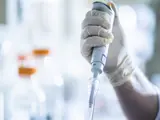Reduce error and repeat analysis in the analytical lab with CHROMacademy training courses
Repeat analysis as a result of avoidable errors can incur huge, unnecessary cost. Investing in consistent, structured training reduces error and saves money.
Get in touch today to find out how CHROMacademy improves practical skills and knowledge while reducing costly errors.

The Root Causes of Repeat Analysis
Watch this short, informative presentation on the root causes of repeat analysis in the lab. This video highlights the difference training programs can make in in reducing errors and repeat analysis—the results are eye-opening.
We reviewed 1000s of repeat analyses
Repeating an analysis is time-consuming. It's a duplication of effort for several members of lab staff, and prevents them—and the instruments they are working with—from moving on to the next analysis. Any reduction represents a significant improvement to revenue.
The average rate of repeat analysis is around 5%. But it can be as high as 20% where training, methods, and maintenance are poor and staff turnover is high. Compare that to labs that are trained well on suitable methods, and that can drop to as low as 0.5%. That's a huge revenue adjustment, just from introducing effective training.

Each repeat analysis
costs $1,800

Nearly 60% of repeat analysis
is caused by human error

This costs ~$8,600 per analyst
per year with a 1/20 failure rate

Save time and money
Most errors come about when the basics aren't done correctly. These avoidable errors lead to costly downtime and reanalysis, which are frustrating for staff and customers. Tight deadlines and downtime are incompatible.
CHROMacademy provides training programs that give your lab staff the skills and knowledge they need to succeed. Well trained staff make fewer mistakes and have the confidence to tackle routine maintenance or troubleshoot problems.
Reducing errors leads to lower maintenance costs, fewer repeat analyses, greater autonomy and an overall increase in output.
The causes of repeat analysis
Human error is preventable in chromatography workflows but it is attributed to 60% of repeat analysis.
While some of the main causes of human error are difficult to address quickly with training—for instance system setup and sequence/vialing error— at least half can be mitigated with very basic technique training. Standard preparation, contamination, and errors in the preparation of sample, mobile phase, and reagents—basic stuff.
Whatever source of error, it all comes back to training. While human error can be improved by teaching better lab skills, hardware faults can be reduced with sufficient method development and validation knowledge.


Error reduction: the human factor
While training cannot completely eradicate errors, it significantly reduces error and reanalysis.
Training someone in their first lab job to a level of basic competency takes roughly 3 months and costs over $15,000. Training often comes at the expense of existing analysts' time and is too task focussed to provide holistic improvements to the new staff member's knowledge.
Foundational training is of paramount importance in developing a highly-efficient analysts that makes minimal errors.
Training isn't only for early-career scientists, it's also important in developing more advanced skills such as method development and mass spectrometry.
